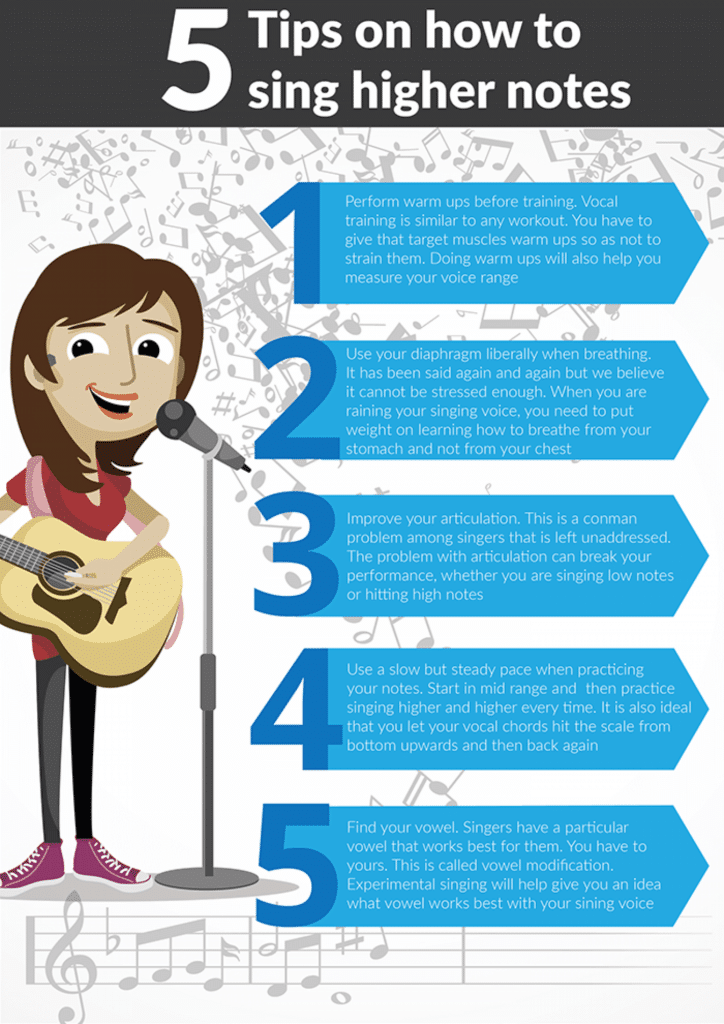
In “How To Sing Better And Higher,” you will discover simple yet effective techniques to enhance your singing abilities and reach higher notes with ease. Whether you’re a beginner or an experienced singer looking to improve your vocal range, this article provides valuable insights and practical tips that will help you develop a stronger, more powerful voice. By implementing these techniques into your practice routine, you can take your singing to the next level and unlock your full potential as a vocalist. Get ready to soar to new heights and captivate your audience with your improved singing skills!

Breathing Techniques
Diaphragmatic Breathing
One important aspect of singing better and hitting higher notes is mastering proper breathing techniques. Diaphragmatic breathing, also known as deep breathing, is a technique that helps singers control their breath and generate more power and support for their voice. With diaphragmatic breathing, you use your diaphragm muscles – which are located below your lungs – to inhale deeply and fully expand your abdomen, rather than shallowly breathing into your chest. This allows for a greater lung capacity and better control of your vocal output.
To practice diaphragmatic breathing, find a comfortable position either sitting or standing. Place one hand on your chest and the other on your abdomen. Take a slow, deep breath in through your nose, feeling your abdomen expand outward as you inhale. As you exhale through your mouth, focus on keeping your chest relaxed and allowing your abdomen to gently contract. Repeat this exercise several times to develop the habit of diaphragmatic breathing.
Controlled Exhalation
Another breathing technique that can greatly improve your singing ability is controlled exhalation. This technique focuses on regulating the flow of air as you sing, allowing for sustained notes and greater vocal control. By controlling the release of air during exhalation, you can effectively manage your breath and avoid running out of breath too quickly.
To practice controlled exhalation, choose a comfortable note to sing. Take a deep breath in using diaphragmatic breathing, and as you begin to exhale, imagine a thin stream of air flowing out of your mouth. Aim to maintain a steady and controlled flow of air throughout the duration of the note. This technique will not only help you sustain notes for longer periods but will also improve the overall control and clarity of your singing.
Support from the Abdominal Muscles
In addition to breathing techniques, it’s essential to engage and strengthen your abdominal muscles to provide proper support for your voice. Your abdominal muscles play a crucial role in maintaining breath control and steady vocal output. By strengthening these muscles, you can enhance your vocal power and control, ultimately allowing you to sing better and hit higher notes effortlessly.
To engage and strengthen your abdominal muscles, try doing exercises such as planks, sit-ups, or Pilates exercises that target the core area. By consistently working on your core strength, you’ll notice a significant improvement in your ability to support your voice and sing with greater ease.
Vocal Warm-Up Exercises
Lip Trills
Before diving into singing, it’s essential to warm up your vocal cords and muscles to prevent straining or injuring them. One effective warm-up exercise is lip trills. Lip trills help to relax and loosen the muscles around the vocal cords, ensuring smoother and more controlled vocal production.
To perform lip trills, place your fingertips lightly on your cheeks and slightly part your lips. Take a deep breath and exhale as you gently blow air through your lips, creating a buzzing sound. Start by doing lip trills on a comfortable range and gradually move up and down your vocal range. This exercise not only warms up your vocal muscles but also aids in developing better breath control and improving your vocal flexibility.
Humming
Humming is another excellent warm-up exercise that helps to gently activate the vocal cords and increase their flexibility. Humming allows for a more focused airflow, enabling better resonance and tone production in your singing.
To do this exercise, close your lips lightly and produce a gentle hum, starting from a low pitch and gradually moving higher. Focus on maintaining a relaxed and consistent airflow as you hum. Experiment with different vowel sounds while humming to further enhance your vocal flexibility and warm up different areas of your voice. Humming can also be great for relieving tension and stress before a singing performance.
Tongue Rolls
Tongue rolls, also known as tongue trills, are an excellent exercise to warm up the muscles in your tongue and improve articulation and diction. This exercise helps to increase the flexibility and coordination of your tongue, allowing for crisper and clearer vocal execution.
To perform tongue rolls, relax your tongue and let it rest gently behind your bottom teeth. Slowly exhale while lightly vibrating your tongue by rolling it backward and forward. Begin with a low pitch and gradually move higher. Focus on maintaining a relaxed and controlled airflow as you perform the tongue rolls. This exercise will not only warm up your tongue muscles but also improve your overall vocal control and precision.
Sirens
Sirens are a fun and effective warm-up exercise that helps to stretch and extend your vocal range. Sirens involve smoothly transitioning from your lowest pitch to your highest pitch or vice versa in one continuous glide. This exercise helps to offset any vocal tension, relaxes the voice, and prepares your vocal cords for singing higher or lower notes.
To perform sirens, start at your comfortable speaking pitch and slowly slide up or down in pitch, imitating the sound of a siren. Ensure that your transition is smooth and gradual, avoiding any abrupt shifts. Aim to explore all areas of your vocal range while doing sirens, allowing your voice to stretch and warm up gradually. This exercise is particularly beneficial for singers aiming to develop a broader vocal range and reach higher or lower notes with ease.
Staccato Scales
Staccato scales are an excellent warm-up exercise that helps to improve your vocal agility, control, and precision. This exercise involves singing scales with short and separate notes, emphasizing the crispness and clarity of each note.
To perform staccato scales, choose a comfortable scale such as the major scale, and start by singing the scale with short, detached notes. Focus on enunciating each note clearly without carrying the sound too long. As you ascend and descend the scale, maintain a consistent and steady rhythm, ensuring that each note is distinct and well-articulated. This exercise is particularly useful for developing better diction, rhythm, and overall vocal control.

Improving Vocal Range
Stretching Exercises
Expanding your vocal range requires flexibility and strength in the muscles involved in producing sound. Stretching exercises specifically targeting these muscles can greatly aid in widening your range and improving the quality of your singing.
One effective stretching exercise is the lip trill stretch. Begin by performing lip trills as a warm-up exercise, but instead of moving up and down your vocal range, focus on stretching your voice upward by gradually moving higher and carefully sustaining the notes. The lip trill action helps to gently stretch your vocal cords and the surrounding muscles, allowing for greater range and resonance.
Another advantageous stretching exercise is yawning. Yawning opens up your throat and stretches the muscles involved in producing sound. To perform a yawning stretch, take a deep breath, then exhale gently as you let out a slow, relaxed yawn. Focus on feeling the stretch in your throat and upper chest area. Yawning stretches the muscles involved in vocal production and can help you reach higher notes with more ease.
Vowel Modification
Vowel modification is a technique used by singers to adjust the shape and placement of the vocal tract to optimize resonance and achieve a broader vocal range. By modifying vowels, you can often sing higher notes with more ease and clarity.
To practice vowel modification, start by singing a sustained note on a comfortable vowel sound, such as “ah.” As you ascend in pitch, gradually modify the vowel sound to a brighter and more closed sound like “uh” or “ee.” Experiment with different vowel modifications and find the ones that work best for your voice and desired range extension. With practice, vowel modification can significantly improve your ability to hit higher notes comfortably and with better control.
Phonation Exercises
Phonation exercises target the coordination and control of the vocal cords, allowing for better pitch accuracy, resonance, and flexibility. These exercises can help in improving your vocal range by strengthening the muscles involved in producing sound and enhancing your vocal control.
One effective phonation exercise is sirens. As discussed earlier in the vocal warm-up exercises section, sirens involve smoothly gliding up and down your vocal range. By practicing sirens regularly and gradually expanding the range of your glides, you can gradually extend your vocal range.
Another phonation exercise is the “ng” exercise. Start by singing a sustained “ng” sound, like the consonant sound at the end of the word “sing.” Begin on a comfortable pitch and gently slide up or down in pitch while maintaining the “ng” sound. This exercise helps to achieve better vocal cord coordination and flexibility, allowing you to reach higher or lower pitches with greater ease.
Proper Posture and Alignment
Stand Tall
Maintaining proper posture while singing is crucial for optimal breath control, vocal resonance, and overall performance. When standing tall, your body is properly aligned, allowing for better vocal production and efficiency.
To achieve proper standing posture, imagine a string attached to the top of your head gently pulling you upward, lengthening your spine. Stand with your feet hip-width apart and your weight evenly distributed on both feet. Avoid slouching or leaning too far forward or backward. Standing tall opens up space for your lungs to fully expand and enables better airflow, ultimately improving both the quality and control of your singing.
Relax the Shoulders
Tension in the shoulders can restrict proper breath support and limit the freedom of your voice. Keeping your shoulders relaxed and stress-free is essential for achieving optimal vocal performance.
To relax your shoulders, begin by raising them slightly toward your ears, then roll them backward in a circular motion, and finally let them drop down naturally. Take a moment to ensure that your shoulders are relaxed and not tensed up. Avoid any unnecessary tension in this area as it can hinder your breath support and vocal production.
Engage the Core
Engaging your core muscles is another key element of maintaining proper posture and alignment while singing. A strong and active core provides stability and support for your breath control, allowing for more precise and controlled vocal output.
To engage your core muscles, imagine gently pulling your belly button toward your spine to activate your abdominal muscles. This should create a slight contraction in your lower abdomen. Avoid over-engaging or tensing your core muscles, as this can restrict your breath flow. Finding a balance between engaging your core and maintaining relaxation in this area is crucial for optimal vocal performance.
Align the Head and Neck
Proper alignment of your head and neck is essential for optimal vocal production and resonance. A misalignment in this area can lead to tension, strain, and limitation in your singing ability.
To align your head and neck properly, ensure that your head is in a neutral position, not tilted forward or backward. Imagine that a string is gently pulling the crown of your head toward the ceiling, elongating your neck. Avoid any unnecessary tension in the neck area and allow for a relaxed and aligned posture. This proper alignment allows for greater breath control, improved vocal resonance, and a more confident singing posture.

Resonance Techniques
Forward Placement
Forward placement is a resonance technique that involves directing the sound toward the front of the mouth and nasal cavity, resulting in a clear and resonant tone. By focusing the sound forward, you can enhance the brightness and projection of your voice.
To practice forward placement, start by humming a comfortable pitch. As you hum, try to feel the vibrations in the front of your face, specifically around your nose, lips, and upper teeth. Gradually transition from humming to sustain a vowel sound, such as “ee” or “ah,” while maintaining the forward placement sensation. Pay attention to the clarity and resonance of your sound as you practice this technique. With consistent practice, you can develop a more forward-focused tone, which can greatly contribute to improved singing quality.
Nasal Resonance
Nasal resonance is a technique that focuses on utilizing the nasal cavity to create a richer and fuller sound. By allowing some resonance to occur in the nasal passages, you can add depth and warmth to your voice.
To practice nasal resonance, start by producing a sustained “n” sound, like the initial sound in the word “sing.” Gradually transition from the “n” sound to a sustained vowel sound, such as “ah” or “ee,” while maintaining the sensation of resonance in the nasal area. Experiment with different vowel sounds and observe the changes in resonance as you practice this technique. Nasal resonance adds a unique quality to your voice and can greatly enhance your singing performance when used appropriately.
Mix Voice
Mix voice, also known as the middle voice, refers to finding a balance between chest voice (lower register) and head voice (higher register). By blending these two registers, you can achieve a smoother and more seamless transition between different vocal ranges, allowing for more flexibility and control.
To practice mix voice, start by singing a comfortable note in your chest voice. Gradually transition smoothly into your head voice while maintaining the same volume and clarity. Focus on achieving a consistent and connected tone throughout the transition, avoiding any sudden or noticeable shifts in vocal quality. Mix voice requires practice and experimentation to find the right balance between chest voice and head voice for your unique voice. With time and consistent practice, you can develop a strong and versatile mix voice, enabling you to sing higher notes with confidence.
Articulation and Diction
Tongue Twisters
Tongue twisters are a fun and effective way to improve your articulation and diction skills. These challenging phrases help to train the muscles of your tongue, lips, and jaw, promoting clearer and more precise pronunciation.
To practice tongue twisters, choose a few phrases with challenging combinations of sounds and repeat them several times at a moderate pace. Focus on enunciating each word and sound clearly, paying attention to the coordination of your tongue, lips, and jaw. Start with simpler tongue twisters and gradually progress to more complex ones as you become more comfortable. Regular practice of tongue twisters can greatly enhance your overall articulation and diction when singing.
Lip Exercises
Lip exercises are an effective way to warm up and strengthen the muscles involved in pronunciation and enunciation. By targeting the muscles of your lips, you can improve your control and precision in articulating various sounds.
One useful lip exercise is the “lip trill.” This exercise, previously mentioned in the vocal warm-up exercises section, not only helps with breath control but also stretches and activates the muscles in your lips. To perform lip trills, slightly part your lips and blow air through them to create a buzzing sound. Move up and down your vocal range while maintaining the lip trill action. This exercise aids in developing better control of your articulation and promotes clarity in your singing.
Another helpful lip exercise is the “buzzy lip” exercise. Start by pressing your lips together gently and produce a buzzing sound by exhaling gently through them. This exercise helps to strengthen the muscles in your lips and promotes better precision in pronouncing various sounds. Experiment with different sounds and words while performing the buzzy lip exercise to further enhance your articulation skills.

Emotional Connection and Expression
Interpreting Lyrics
An essential aspect of singing is delivering a meaningful and emotionally captivating performance. Interpreting the lyrics of a song allows you to connect with the message and convey the intended emotions to your audience effectively.
To interpret lyrics, start by reading and analyzing the meaning behind the words. Consider the context, emotions, and story the lyrics convey. Pay attention to the subtle nuances and inflections of each phrase, aiming to express the intended emotions authentically. Experiment with different vocal dynamics, phrasing, and tonal variations to bring out the desired emotions in your performance. By investing time in understanding and interpreting lyrics, you can connect with the song on a deeper level, resulting in a more engaging and expressive singing performance.
Connecting with the Audience
Connecting with your audience is crucial for creating a memorable and impactful performance. Engaging your audience through eye contact, body language, and genuine expression allows them to connect with you and your music on a personal level.
To connect with your audience, maintain eye contact with individuals in different areas of the audience throughout your performance. Acknowledge their presence and establish a sense of connection. Utilize open and inviting body language, such as relaxed and upright posture, gestures that complement the emotions of the song, and intentional movements that enhance your overall performance. Additionally, let your genuine emotions and passion for the music shine through your facial expressions and vocal delivery. By actively connecting with your audience, you can create a more memorable and impactful singing experience for both you and your listeners.
Avoiding Vocal Strain
Hydration
Proper hydration plays a vital role in maintaining vocal health and preventing vocal strain. Adequate hydration helps to keep your vocal cords lubricated, allowing for smoother vocal production and reducing the risk of vocal strain or injury.
To stay properly hydrated, drink plenty of water throughout the day. Aim for at least eight 8-ounce glasses of water daily, and more if you engage in intense physical activity or perform for extended periods. Avoid or minimize the consumption of dehydrating beverages, such as caffeinated or alcoholic drinks, as they can dry out your vocal cords. Additionally, consider using a humidifier in your environment to keep the air moist, particularly during dry seasons or in locations with low humidity. Proper hydration is essential for maintaining vocal health and preventing strain.
Avoiding Vocal Fry
Vocal fry, characterized by a low and creaky vocal quality, can strain and damage your vocal cords if used excessively or incorrectly. Avoiding vocal fry helps to preserve the health and longevity of your voice.
To avoid vocal fry, pay attention to your vocal technique and ensure you are not excessively using your vocal fry register. Make sure your breath support is sufficient and consistent, as inadequate breath control can contribute to vocal fry production. Warm up your voice properly before singing or speaking for extended periods, as a well-warmed-up voice is less likely to slip into vocal fry. If you notice any strain or discomfort during singing or speaking, take a break, rest your voice, and seek proper vocal training if necessary. By being mindful of vocal fry and its potential adverse effects, you can protect your voice and maintain its integrity.
Proper Vocal Rest
Giving your voice proper rest is crucial for vocal health and preventing strain or fatigue. Overuse or excessive strain can lead to vocal deterioration and potential vocal cord damage.
To ensure proper vocal rest, avoid straining your voice unnecessarily and take regular breaks when performing or practicing for extended periods. Incorporate ample periods of silent rest throughout the day to allow your vocal cords to recover. Limit excessive talking or yelling, particularly in noisy environments where you may strain to be heard. Adequate sleep is also essential for vocal health, as it allows your body to rest and rejuvenate, including your vocal cords. Prioritize rest and care for your voice to maintain optimal vocal health and prevent strain.

Pitch Accuracy and Intonation
Ear Training
Developing a keen ear for pitch accuracy and intonation is essential for singing better and hitting higher notes consistently. Ear training exercises can greatly improve your ability to distinguish between different pitches and reproduce them accurately.
One effective ear training exercise is singing intervals. Start by practicing simple intervals, such as ascending and descending major or minor seconds, using a piano or keyboard as a reference for pitch accuracy. Gradually progress to more complex intervals, focusing on hearing and reproducing the correct pitches. Consistent practice of ear training exercises enhances your ability to recognize and reproduce pitch accurately, ultimately improving your overall intonation and pitch accuracy while singing.
Interval Exercises
Interval exercises are a great way to train your voice to hit higher notes with precision and confidence. By practicing intervals, you can gradually expand your vocal range and develop better control over your voice.
To practice interval exercises, start by singing a simple interval, such as a major or minor third, using a piano or keyboard as a reference for pitch accuracy. Experiment with ascending and descending intervals, gradually increasing the difficulty as you become more comfortable. Focus on sustaining each note within the interval and ensuring that the transition from one note to the next is smooth and accurate. Consistent practice of interval exercises can greatly improve your pitch accuracy and intonation when singing higher notes.
Working with a Vocal Coach
Finding a Qualified Coach
Working with a knowledgeable and experienced vocal coach is invaluable in improving your singing ability and expanding your vocal range. A qualified vocal coach can provide guidance, personalized instruction, and feedback tailored to your unique voice and goals.
When seeking a vocal coach, research their credentials, training, and experience. Look for coaches who have a strong vocal background, teaching certification, and a track record of successful client outcomes. Consider seeking recommendations from trusted sources, such as other singers or music professionals, to ensure credibility and quality. Additionally, schedule initial consultations or trial lessons to assess the coach’s teaching style, compatibility, and your comfort level with their approach. Finding a qualified vocal coach is a crucial step in your journey to singing better and hitting higher notes.
Setting Goals
Setting clear and achievable goals is essential when working with a vocal coach. A vocal coach can assist you in identifying your strengths and areas for improvement, as well as guide you in setting realistic and measurable goals that align with your vocal aspirations.
Communicate your goals to your vocal coach, whether it’s improving vocal range, enhancing vocal control, or mastering a specific singing technique. Your coach can create a tailored plan that includes exercises, vocal drills, and repertoire selections to help you progress toward your goals. Collaboratively establishing achievable milestones and regularly reviewing and adjusting them with your coach ensures that you stay on track and see consistent improvement in your singing ability.
Personalized Feedback
One significant advantage of working with a vocal coach is the personalized feedback and guidance they provide. A coach can identify areas for improvement, correct technical issues, and offer constructive criticism that helps you refine your singing technique and reach new vocal heights.
Regularly attending vocal coaching sessions allows your coach to closely monitor your progress, identify areas of weakness, and provide specific feedback and exercises to address those areas. Embrace the feedback and suggestions provided by your coach, and actively apply them in your practice and performances. Their objective and experienced perspective can greatly accelerate your growth as a singer and help you achieve your vocal goals.
In conclusion, singing better and hitting higher notes requires a holistic approach that encompasses various techniques and practices. By mastering breathing techniques, engaging in vocal warm-up exercises, improving vocal range, maintaining proper posture, utilizing resonance techniques, enhancing articulation and diction, establishing emotional connection, avoiding vocal strain, improving pitch accuracy and intonation, and working with a skilled vocal coach, you can unlock your full potential as a singer and elevate your performances to new heights. With consistent practice, dedication, and a friendly tone.




